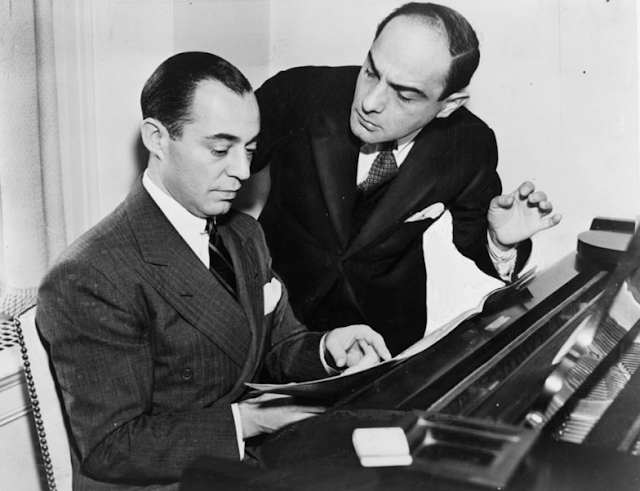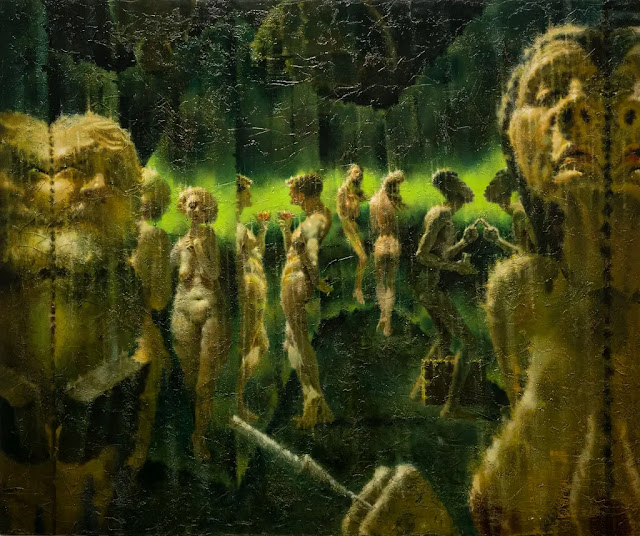photo courtesy Landmark West!
On October 31, 1925, the Record & Guide pointed out, "Central Park West is now attracting the attention of apartment house builders and operators." It went on to say that the latest project was a $1,325,000 building being erected by the 415 Central Park West Corporation. "It will contain about 112 apartments," said the article, noting that "a library is included in the seven-room suites."
The Central Park View Apartments, on the northwest corner of Central Park West and 101st Street, opened in 1926. Designed by Deutsch & Schneider in the neo-Regency style, the 16-floor and penthouse structure was formally symmetrical. The three-story base was anchored by limestone corners, its double-height entrance supporting two pairs of neo-Classical urns. The ten-story mid-section was faced in red Flemish-bond brick. At the 14th and 15th floors, faux balconies sprouted 2-story stone surrounds and pilasters.
Real Estate Record & Builders' Guide, October 31, 1925
The Central Park View Apartments offered suites of four rooms and two baths, and six- or seven-rooms apartments with three baths. A 1926 brochure said, "The two 6 room apartments are ideal, each being in effect a Private Home, extending through the full length of the building from east to west with no long halls; the maid's quarters, including the kitchen, occupying the entire rear, and the kitchens of both apartments connected with a service elevator and service stairway."
The up-to-the-minute amenities included lighted closets (the smallest apartments had five closets while the largest had ten, including a cedar closet). The brochure noted, "The floors are of hardwood, in herringbone design; solid brass and bronze hardware has been used throughout...In keeping with all else, every apartment has up-to-date electric refrigeration--individual equipment in every kitchen."
The two penthouse apartments were marketed as "roof garden apartments," and called "a feature of this building." One had six rooms, the other seven rooms. The 1926 brochure said, "The roof is entirely of red tile, and a liberal landscaping effect is provided around these apartments. Elevator service, of course."
Among the initial residents of one of the penthouse apartments was the musical comedy lyricist Lorenz Hart. He moved in with his parents, Max and Frieda Hart. According to Gary Marmorstein, in his A Ship Without a Sail--The Life of Lorenz Hart, the family moved here from their 119th Street house to be on one floor. Max Hart "was having an increasingly painful time negotiating a flight of stairs."
Max's deteriorating condition did not improve. According to Marmorstein, on the night of October 8, 1928, with Lorenz and his brother Theodore at his bedside, Max said, "I'm going to die tonight. Don't wake your mother, though. Let her sleep." He was 68 years old.
Early in the summer of 1929, Lorenz Hart and his partner, Richard Rodgers, received an offer from producer Laurence Schwab to contribute songs for the movie version of the Broadway musical Follow Thru. To celebrate, Hart hosted an open house. Variety reported, "Larry Hart threw an endurance party at his place the other a.m. Broke all pent-house records."
Lorenz and Frieda Hart remained in the Central Park View Apartments until August 1939 when they moved about nine blocks south to the Ardsley, at 320 Central Park West.
Illustrator Peter Arno and his wife, Lois Long, were also initial residents. Born Curtis Arnoux Peters, Jr., Arno was perhaps best known for his covers for The New Yorker. He began contributing cover designs in 1925, the year of the magazine's founding. He branched into the theater, producing, designing and writing four Broadway shows, beginning with the 1931 Here Goes the Bride.
Peter and Lois most likely met through The New Yorker. Lois had been a journalist for Vogue and Vanity Fair before being hired to write an anonymous nightlife column for The New Yorker. Using the pseudonym "Lipstick," her witty chronicles of Manhattan nightclubs and society capers made her a celebrity--albeit an anonymous one. She married Peter Arno in 1927.
The couple's professional interaction seems to have been more successful than their domestic situation. Their arguments turned violent, and on January 20, 1930, the Daily News headlined an article, "Peter Arno, Cartoonist, Hides From Wife to Nurse His Scars / Split With Lois Long, Says It's Friendly." The final altercation was apparently heard by neighbors, Time magazine reporting that the couple "quarreled bitterly in the middle of the night." Arno left the Central Park View Apartments and he and Lois divorced the following year.
Another tenant associated with The New Yorker was writer and critic Alfred Kazin and his wife, the former Natasha Dohn. The couple moved in on November 18, 1948. Kazin's reviews appeared in The New Yorker as well as the New York Herald-Tribune, The New York Times, and The New Republic. His 1951 memoir, A Walker in the City was a finalist for the National Book Award for Nonfiction, as were its sequels, the 1965 Starting Out in the Thirties and New York Jew, published in 1978.
Novelist Padraic Colum and his wife, Mary (known as Molly) Maguire, moved in around 1933 after spending three years living in France. A major figure in the Irish Literary Revival movement, Colum covered all the literary bases--novelist, dramatist, children's author, playwright, poet and biographer.
Mollie Colum died in 1957 while co-writing Our Friend James Joyce with Padraic. He finished the book about their close relationship with the Irish novelist and poet, which was published in 1958.
Jazz vocalist and civil rights activist Abbey Lincoln was another celebrated resident. In her 2017 Dizzy Duke, Brother Ray and Friends--On and Off the Record With Jazz Greats, Lilian Terry recalls, "it became customary that I accept [Abbey's] hospitality at her New York apartment at 415 Central Park West."
Abbey Lincoln was one of the long list of impressive musicians who lived in the Central Park View Apartments that included drummers Art Blakey, Max Roach and Elvin Jones; jazz pianists Teddy Wilson and Dwike Mitchell; lyricist Yip Harburg; and cellist Marion Cumbo. Singer, songwriter, composer and civil rights activist Nina Simone moved into the building in 1960, following her divorce from Donald Ross.
By 1970, science fiction and fantasy author Robert E. Margroff lived here. His first story, "Monster Tracks," was published in 1964, after which he mostly co-authored novels with Piers Anthony. They included the five-book series Kelvin of Rud.
A fascinating tenant was artist Bradford Boobis, who lived here with his wife Shawn. Starting out as a Hollywood composer, he turned to painting. The self-taught artist was highlighted in a 1969 edition of American Artist, which said, "His work indicates that he has thoroughly mastered oil technique, draughtsmanship and craftsmanship." A year later three of Boobis's works were chosen to be displayed at the Metropolitan Museum of Art's Library of President Papers. American Artist pointed out that he was the only living artist represented in the exhibition.
Boobis suffered a heart attack on January 16, 1972 and died on his way to the hospital at the age of 43. Writing in The New York Times half a century later on April 3, 2023, Joshua Needelman recalled that on the night of his death, "fearing that his widow might sell them," four of his "most dedicated devotees" entered the Boobis apartment and "surreptitiously removed roughly a dozen of his paintings, which depicted naked figures amid distorted surroundings."
The paintings were shipped to London to Robert Anthony Rayne, a member of the British peerage. In June 2022 they were briefly returned to New York City for a showing at the Meisel Gallery. Louis K. Meisel told Needelman that two of the paintings were "as great as anything I'd ever seen in realism and surrealism or anything representational."
Stage, television and motion picture actor Edward Emerson and his wife, the former Edith Broder, lived here at the time of Boobis's death. Born in 1903, Emerson appeared on Broadway in shows like Hilda Cassidy; Heigh-ho, Everybody; and Crime Marches On. His film career included roles in the 1936 Cover Chinatown, Behind the Criminal the following year, and There Goes Kelly in 1945.
photo courtesy Landmark West!
While not as architecturally dazzling as some of the thoroughfare's well-known Art Deco structures, the Central Park View Apartments plays an important role in the Central Park West streetscape.
no permission to reuse the content of this blog has been granted to LaptrinhX.com







.png)

No comments:
Post a Comment